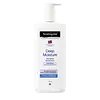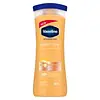What's inside
What's inside
 Key Ingredients
Key Ingredients

No key ingredients
 Benefits
Benefits

 Concerns
Concerns

 Ingredients Side-by-side
Ingredients Side-by-side

Water
Skin ConditioningGlycerin
HumectantIsopropyl Myristate
EmollientStearic Acid
CleansingGlyceryl Stearate
EmollientParaffinum Liquidum
EmollientEthylhexyl Methoxycinnamate
UV AbsorberNiacinamide
SmoothingTriethanolamine
BufferingDimethicone
EmollientPhenoxyethanol
PreservativeButyl Methoxydibenzoylmethane
UV AbsorberParfum
MaskingCarbomer
Emulsion StabilisingMethylparaben
PreservativeTitanium Dioxide
Cosmetic ColorantCetyl Alcohol
EmollientGlutamic Acid
HumectantSodium PCA
HumectantPropylparaben
PreservativePetrolatum
EmollientSodium Hydroxide
BufferingDisodium EDTA
Hydrated Silica
AbrasiveAluminum Hydroxide
EmollientAlginic Acid
Skin ConditioningBHT
AntioxidantSodium Carbonate
BufferingXanthophylls
Skin ConditioningSodium Chloride
MaskingBenzyl Alcohol
PerfumingBenzyl Salicylate
PerfumingCitronellol
PerfumingCitrus Aurantium Peel Oil
Citrus Limon Peel Oil
MaskingGeraniol
PerfumingGeranyl Acetate
PerfumingHexyl Cinnamal
PerfumingHydroxycitronellal
PerfumingLimonene
PerfumingLinalool
PerfumingLinalyl Acetate
MaskingPinene
MaskingTerpineol
MaskingWater, Glycerin, Isopropyl Myristate, Stearic Acid, Glyceryl Stearate, Paraffinum Liquidum, Ethylhexyl Methoxycinnamate, Niacinamide, Triethanolamine, Dimethicone, Phenoxyethanol, Butyl Methoxydibenzoylmethane, Parfum, Carbomer, Methylparaben, Titanium Dioxide, Cetyl Alcohol, Glutamic Acid, Sodium PCA, Propylparaben, Petrolatum, Sodium Hydroxide, Disodium EDTA, Hydrated Silica, Aluminum Hydroxide, Alginic Acid, BHT, Sodium Carbonate, Xanthophylls, Sodium Chloride, Benzyl Alcohol, Benzyl Salicylate, Citronellol, Citrus Aurantium Peel Oil, Citrus Limon Peel Oil, Geraniol, Geranyl Acetate, Hexyl Cinnamal, Hydroxycitronellal, Limonene, Linalool, Linalyl Acetate, Pinene, Terpineol
Ingredients Explained
These ingredients are found in both products.
Ingredients higher up in an ingredient list are typically present in a larger amount.
Carbomer is a polymer of acrylic acid. Its main role is to create a gel consistency.
A high amount of carbomer can cause pilling or balling up of products. Don't worry, most products contain 1% or less of carbomer.
Cetyl Alcohol is a fatty alcohol. Fatty Alcohols are most often used as an emollient or to thicken a product.
Its main roles are:
Though it has "alcohol" in the name, it is not related to denatured alcohol or ethyl alcohol.
The FDA allows products labeled "alcohol-free" to have fatty alcohols.
Learn more about Cetyl AlcoholGlycerin is already naturally found in your skin. It helps moisturize and protect your skin.
A study from 2016 found glycerin to be more effective as a humectant than AHAs and hyaluronic acid.
As a humectant, it helps the skin stay hydrated by pulling moisture to your skin. The low molecular weight of glycerin allows it to pull moisture into the deeper layers of your skin.
Hydrated skin improves your skin barrier; Your skin barrier helps protect against irritants and bacteria.
Glycerin has also been found to have antimicrobial and antiviral properties. Due to these properties, glycerin is often used in wound and burn treatments.
In cosmetics, glycerin is usually derived from plants such as soybean or palm. However, it can also be sourced from animals, such as tallow or animal fat.
This ingredient is organic, colorless, odorless, and non-toxic.
Glycerin is the name for this ingredient in American English. British English uses Glycerol/Glycerine.
Learn more about GlycerinParaffinum Liquidum is also known as liquid paraffin. It is a type of highly refined mineral oil.
Like other oils, Paraffinum Liquidum has emollient properties. Emollients help soothe and soften the skin. By creating a barrier to trap moisture within, emollients help keep your skin hydrated.
Paraffinum Liquidum does not irritate the skin and is non-comedogenic.
Learn more about Paraffinum LiquidumPhenoxyethanol is a preservative that has germicide, antimicrobial, and aromatic properties. Studies show that phenoxyethanol can prevent microbial growth. By itself, it has a scent that is similar to that of a rose.
It's often used in formulations along with Caprylyl Glycol to preserve the shelf life of products.
Sodium Hydroxide is also known as lye or caustic soda. It is used to adjust the pH of products; many ingredients require a specific pH to be effective.
In small amounts, sodium hydroxide is considered safe to use. However, large amounts may cause chemical burns due to its high alkaline.
Your skin has a natural pH and acid mantle. This acid mantle helps prevent harmful bacteria from breaking through. The acid mantle also helps keep your skin hydrated.
"Alkaline" refers to a high pH level. A low pH level would be considered acidic.
Learn more about Sodium HydroxideWater. It's the most common cosmetic ingredient of all. You'll usually see it at the top of ingredient lists, meaning that it makes up the largest part of the product.
So why is it so popular? Water most often acts as a solvent - this means that it helps dissolve other ingredients into the formulation.
You'll also recognize water as that liquid we all need to stay alive. If you see this, drink a glass of water. Stay hydrated!
Learn more about Water